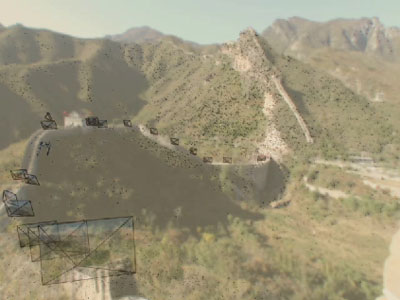Austin-powered
So, I’ll be back at the fine SXSW Interactive conference/festival in Austin this year. Last year I spewed forth on convergence (skeptically). This year I get to orchestrate the spewage as I am leading a panel on virtual worlds, one of a handful on the topic in the Gaming/Screenburn category.
The panel’s called “Terraforming the Internet: When 3D Models Meet Business Models.” Saturday, March 10, 10am. Panelists are being finalized, but they’re all brilliant, articulate, laureates-in-waiting.
SXSW is simply an exceptional event and I’m happy to be a part of it. See you there?
See also: South by
Twelve islands
It isn’t exactly news that IBM is interested in virtual worlds, but Friday represented a bit of a milestone when we unveiled our official land in Second Life — twelve interlinked islands, open and built-out for business use, research, internal collaboration, and anything else we can think of. As always, Eightbar has the inside scoop.

It’s exciting times, but not because we’re in Second Life. We’ve been working in SL for months, albeit without the sanctioned presence that this island megaplex gives us. This is important because it represents the results of collaboration between a somewhat bewildering variety of interests inside IBM and it points to much more to come. This event, the founding and development of the twelve islands and not Sam Palmisano’s announcement in Beijing (much as I loved it), is the real beginning of IBM establishing itself in this space (literally).
But what really interests me — end press release, start me release — is that this will be a springboard to the rest of the metaverse. Second Life itself is but an island, really, a popular walled garden that was one of the first to the game. Zoom out and move forward a few years and SL will be just a powers-of-ten-sized chunk of a much larger universe of virtual worlds. The Forbidden City: Beyond Space and Time will be one, as will thousands of others. In fact, to really make an impact there shouldn’t be distinctions between the various worlds. One should be able to hop about as from webpage to webpage, seamlessly. That’s a bit of a dream these days with the leaders in the industry less interested in standards and interop than community-building. But we’ve seen that before with the browser hell of the early web days and we’ll no doubt see it again.
If you’re in Second Life and would like to visit, just search for IBM on the map and pick an island. There’s a lot to see. I’m Immerito Foley in-world. Ping me if you need a guide.
When the metaverse is your town hall
Tuesday in Beijing I was part of a team that did something truly bizarre and unique. We helped the CEO of IBM, Sam Palmisano, deliver the results of IBM’s Innovation Jam to an audience inside of Second Life. The virtual venue complemented the 8,000 IBM’ers in China he was speaking directly to as well as the hundreds of thousands of colleagues watching the event via internal webcast.
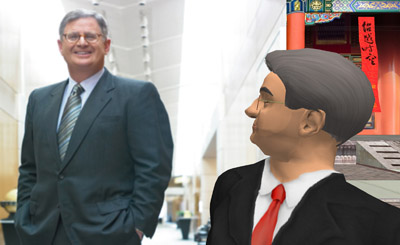
The reason Palmisano did this was to highlight IBM’s commitment to virtual world technology, one of ten new focus areas coming out of the Innovation Jam. (Roo’s got a bit more detail on the other Jam ideas over at Eightbar.) So, rather than just say we’re committed to the space, we figured we’d have Sam show it. Sam carried on a conversation with Irving Wladawsky-Berger, who was at a supercomputing convention in Tampa, via Second Life and phone line while a few dozen IBM’ers from around the world milled about smartly.
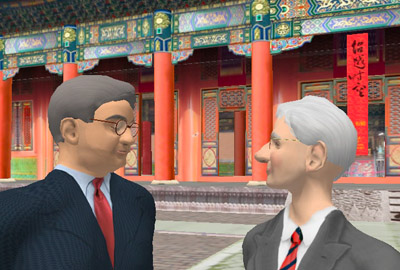
It was truly challenging to pull off, though not for the reasons you might expect. The execs were very positive and open-minded about showing a live interaction in Second Life. Trouble was, preparing for doing so in China was a nightmare of failover and logistical planning. Basically every shred of what we hoped to do live had to be filmed machinima-style as a backup in case we lost the connection. Thankfully, it stayed stable at showtime, but the virtual filming easily consumed 95% of our prep time. You just try corralling talented, curious, script-wielding colleagues in Second Life to serve as virtual extras. It is like arranging toddlers for a photo shoot. Everyone wants to show off their latest set of wings or ability to make it rain. It took forever. Still, we had to have the video. So much easier than trying to explain to 8,000 people that the grid’s down.
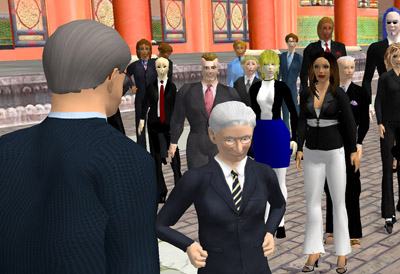
For the actual event, I was in Beijing with small group of colleagues to anchor the Sam-side interaction. We too were organized for failover. One colleague served as the vitual camera person, another was her backup and video triggerer. Others maintained contact with the IBM crowd, directing them and prepping them for the moment when Sam would “enter” the virtual world being displayed to the real audience in Beijing. Virtual webcasting.
The setting for all this was Thinkland, a private IBM island in Second Life that serves as a testbed for the Forbidden City project mentioned here previously. While the project itself will not ultimately live in SL and only launches in 2008, having a ready virtual environment so clearly China-themed was too good to pass up. Thinkland became the “stage” for the virtual event.
The press response has been strong. BusinessWeek had the exclusive (I believe) with ZDNet, Reuters (and their SL bureau), and a slew of others following closely behind.
Can’t wait to see what happens now. IBM’s ad hoc Virtual Universe Community accomplished a stunning amount of work as a non-organization. Let’s hope the new funding and focus doesn’t squelch any of the passion that has fueled the group to date.
UPDATE: Irving blogs this in much greater detail.
Building a virtual world one tourist photo at a time
The phrase “Hey, wanna see my vacation photos?” has stricken fear into the hearts of co-workers and family members since photography was invented. But the combined mass of pics could help build virtual worlds of, well, of the whole photographed world. The University of Washington and Microsoft (believe it or not) have created a jawdropping demo of stitching together disparate photos of the same place into a textured navigable world.
The site is called Photo Tourism, but that doesn’t do justice to what these people have done. Only the videos convey the concept.
Soon enough this will be integrated with Google Earth and its ilk. A virtually navigable earth at all levels of detail can’t be that far off.
Of course, most tourist photos contain people in them. But that appears not to be such a problem either. Witness Tourist Remover. (Oh, to have this in real life.)
Flashmobbing in the virtual Far East
If all the feel-good talk of virtual community and social networking has you wanting to gag, you’ll be pleased to know that mob justice is alive and well in the metaverse too.
The supremely popular Chinese online role-playing game called “The Fantasy of the Journey West” was recently the scene of a massive virtual protest over the depiction of what looked like a Japanese imperial flag inside a traditional Chinese government office. But that makes it sound halfway rational. You have to see the screen grabs of thousands of huddled avatars spewing nationalist rage to fully appreciate the lunacy.
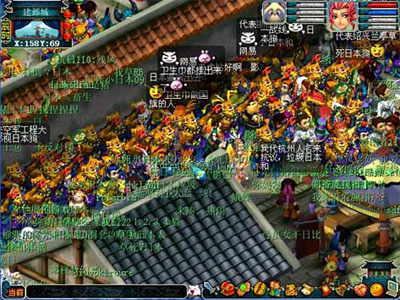
EastSouthWestNorth has the blow-by-blow, while Salon attempts to sort out the mess.
Sheesh, some people sure get upset about flags, you know? Must be an election year in China. No, wait …
Isn’t that spatial?

Nothing left to accomplish now that I’m the subject of a podcast, I guess.
VerySpatial – Episode 51 [16.2 MB, MP3 format]
VerySpatial is the work of three really interesting folks at West Virginia University who focus on geospatial technologies. Sue (pictured right), Jesse, and Frank interviewed me last week after they came across the press hoopla for The Forbidden City: Beyond Space and Time project.
Beware: none of my prolixity or verbal stutters have been edited out. Massive rambling dead ahead!
The a-ha! moment
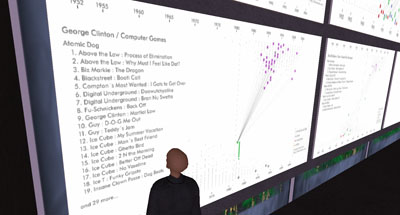
Above, last night’s opening in Second Life of Jesse Kriss’s History of Sampling visualization (SLURL: Ars Virtua New Media Gallery).
A few weeks ago I moderated a panel of artists and technologists at the Aldrich Contemporary Art Museum whose aim was basically to complicate the distinction between the two categories of panelists. It was a great disussion in a superb environment: the Aldrich is a first-rate, forward-thinking museum in Ridgefield, CT, a place you’d never expect it. The germ of the discussion was creativity. How are technical creativity and artistic creativity — “innovation” to be buzzword-compliant — related? Are they analogous? If so, where do the similarities break down?
We stacked the deck a bit by involving technical folks whose work was clearly artful and artists whose medium was heavily technologized, but the audience itself, also involved in the discussion, were from a wide range of both backgrounds. The goal of the day was to try to isolate, such as possible, the moment of inspiration — the moment when you knew you had something worthwhile. How did this come about? Almost everyone said the idea came first and only then was the tool sought to make it real. One of IBM researchers said that if he could perform his complex visualizations with a pencil he would.
This surprised me. One of the great things about technology, it seems to me, is its extensibility in ways not intended by the designer. I figured both groups would see this as inspiration in itself. The artist, perhaps not understanding fully the capabilities of a digital tool, cajoles (even breaks) it in unique ways — while the geek, knowing intimately the capabilities of a particular tool, hacks or applies it in unique ways. Admittedly tool-inspired creativity is only one route, but no one on the panel seemed to put much stock in it. Maybe I’m wrong, but can I be the only person who has loaded an application and thought “Gee, I’d love to make it do X.” The creativity, in part, comes in making the tool behave “improperly.”
The panelists were a great bunch. See for yourself.
See also Geeks in the Gallery, unrelated to the Aldrich event but very relevant to the discussion.
The Forbidden City: Beyond Space and Time
Yesterday in Beijing, China’s Palace Museum and IBM jointly announced The Forbidden City: Beyond Space and Time, the project that I’ve been working on for over a year. Consistent readers of this blog (yes, you three) know that I spend a lot of time in China and so it is a great relief that the cat is officially out of the bag. Not that I’ll be diving into excruciating detail in future posts — gotta save some surprises for the actual launch in 2008, right? — but it should give a bit more context to my musings.
So, what’s the project? Well there’s the official press release and the Palace Museum’s statement (in Chinese). The Chicago Sun-Times decided to take the local angle on the announcement and ran a flattering piece on me and my team. The paper even gave Ascent Stage some love.
But what is Beyond Space and Time? Well, announcements like this at the beginning of a project are always tricky since it is the nature of multi-year, first-of-a-kind efforts to change drastically from vision to implementation. But you have to start somewhere, so here’s the vision.
The heart of Beyond Space and Time is a virtual online replica of the Forbidden City. This is not a set of traditional webpages but rather a fully immersive, spatial, populated world that corresponds architecturally and historically to the vast grounds of the current Palace Museum. And not just pretty building models to ogle at. We call it a Participatory Cultural Environment to stress the importance of a space alive with people — other visitors who you can interact with and, if possible, computer-controlled representations of historic persons. Though 3D representation is widespread in the field of cultural heritage (primarily for preservation), this kind of multi-user, education-focused cultural worlds does not exist.
If you know Second Life, you’re familiar with non-game-based 3D virtual communities. Second Life is an inspiration and even a development sandbox for us (no SLURL, we’re on a private island for now — but we did recently take a SL team portait), but we’re evaluating many platform possibilities. It is sometimes said that people who visit the real Forbidden City leave thinking that they’ve missed the actual Palace Museum. In fact, the buildings and grounds (and of course the artifacts therein) are the Palace Museum; it is not a single building with nice glass cases and wall placards. This is the primary reason that our virtual version is a spatial world rather than a more traditional web front end (however tricked out) for a database of media, as we did with the Hermitage and Eternal Egypt. The museum is a city and the best way to experience a city is by moving through it and interacting with others in it. Call it the sidewalk approach to cultural heritage.
There’s an historical aspect too: that’s the beyond time part. We envision being able to move between a few discrete historical moments in the centuries-long evolution of the city. The environment will morph architecturally and of course the storylines embedded in the world will correspond to the historical moment. System design verges on science fiction here as we move through the implications of a community space that exists on different timelines. For example what happens to the field trip group when some of your classmates decide to peel off for the 16th century?
Of course, a virtual simulacrum of a physical space isn’t much fun if it doesn’t have points of tangency with the real world, now is it? We’re working with our museum partners to identify places inside the Forbidden City where visitors who are physically there can interact with the virtual version of the space. We’re evaluating different location-based services — from projection in the palace halls to mobile device interaction. The idea is to break down the strict distinction between the real world and the virtual world, to let one enhance the other. Challenges like this are one of the many reasons IBM undertakes and funds projects such as Beyond Space and Time.
There’s an aspect to the project that is personally very exciting and not yet reported in the press. Modelling 800 buildings to a level of appropriate detail isn’t something that can realistically be achieved by 2008. We realize this and actually think it is a blessing in disguise. Inspired by the Ancient Spaces project which itself takes a Wikipedia-like approach to collaborative content development, we propose to open the modelling effort to the global community of developers. When exactly this will happen and certainly how it will work is still to be defined, but if you are interested in being part of the distributed virtual construction crew drop me a line at .
In North America I am working with some very talented designers and developers, many of whom have years of experience from earlier museum projects. In China we're working with specialists from IBM's research lab in Beijing as well as a team at the Palace Museum who are as technically-savvy as they are informed about the history and culture inside the Forbidden City walls.
So, then, back to work.
[Note to those of you who read this site's feeds: I've played with a kind of spatial hyperlink that adds some extra information to this post. The content, alas, is not part of the RSS feeds. Drop on by the site if you'd like the extra morsels.]
UPDATE: The virtual world is live and can be found at www.beyondspaceandtime.org.
Two worlds come to life

This past Sunday Chicagoans emerged from their winter bunkers to embrace the first Spring-like weather we’ve had. They did it enthusiastically. Perhaps too much so: it really wasn’t that warm. But goodness what a difference it made. The city was seething with happiness. Everyone was outside, walking, running, playing, being seen, having brunch with friends, perched on stoops, meeting neighbors. If the city is a living organism and sidewalks are the circulatory system then this specimen was near the peak of its cardiovasicular capacity.
I have said it before and I will say it again: there is no city on Earth that does summer as well as Chicago does. The most deliberately savored 90 days anywhere. This past weekend was but a warmup.
Another world came alive this weekend, to me at least. I’ve mentioned my interest in the virtual world known as Second Life. Now, you’re probably thinking, this guy has two kids with a third on the way — of course he needs a second life. Har. Actually I find it fascinating, like I’ve just discovered the web or something (which I remember vividly, thank you Mosaic!) Some colleagues of mine in the UK actually use Second Life for team meetings, an idea that makes a ton of sense since it merges the textual immediacy of chat with the gestural and multimedia capacity of videoconferencing.
My sister and father and I have a bookclub. We rotate selection of the book and it gives us a great excuse to to take a break from our own families and have a lunch together. We usually select a place to eat that has some relationship to the book. (For instance, for one of my Dad’s selections about the Manhattan Project we met near the site of the first successful fission of an atom at the University of Chicago.) The book we read this time was Cast of Shadows, a story about a doctor working at a human cloning clinic (like a reproduction clinic) whose daughter is raped and killed and whose murderer is never caught. The doctor, using semen from the crime scene, clones his daughter’s killer and arranges for him to be raised by a couple out of fertility options. He follows the boy as he grows in hopes of getting a clue to the man — the boy’s genetic clone, of course — who killed his daughter. A significant portion of the book occurs in a virtual environment called Shadow World, furthering the notion of cloning. Well, Second Life is a lot like Shadow World. So we had our bookclub in there, virtually, as avatars in Second Life.
What made this experiment more interesting is that my dad, sis, and I were all physically together in my basement on different computers interacting more or less interchangeably inside and outside of the world. Once we got past the normal new-user issues with my father (forgotten password, all thumbs on the keyboard, etc.) we were off and running — or flying, the mode of transport most useful in SL. It was probably the most enjoyable bookclub we’ve had. I was the tour guide, showing my family around my favorite parts of Second Life like a museum docent. Most of the club meeting was spent looking for somewhere out of earshot of others where we could quietly discuss the book. This was probably a mistake since all we’d really have to do is IM each other in-world, but I found it interesting that we desperately wanted to find some real-world analog (like a coffee shop) to have our conversation.
My father, true to real life, kept getting lost. Luckily I could always offer to teleport him to where my sister and I were. If only we had this ability in real life. Body modification also occupied much of my father’s and sister’s time. My sister — a petite, conservative lawyer in real life — was obsessed with being, well, slutty. She gave herself the biggest boobs allowable, pants that literally were painted on, and lips that were comically oversized. I could hardly look at her for fear of the disturbing possibility of being turned on by a virtual depiction of my own sister. My father, on the other hand, looked like a lifelong beer drinker who focused exclusively on upper-chest muscle toning. We were a motley crew. My sister was deathly afraid of interaction with the other residents of Second Life. (Well, she should have been, dressed like that!) In her mind she had a specific reason for being in SL whereas all these other people were clearly miscreant do-nothings simply prowling about. (This is definitely not the case. In fact it is probably the opposite right now, akin to the early days of the Internet when it was populated only with a certain intelligent stratum of tech-savvy adventurers. Give it time, though. I predict we’ll see the same diversified spamification of Second Life as we’ve seen in e-mail and on the web.)
The session ended, rather poetically, with us all astride a statue of a hippopotamus in a park we stumbled into somewhere. That’s the beauty of SL. Like a second box of chocolates, you still never know what you’re going to get.
(Life)
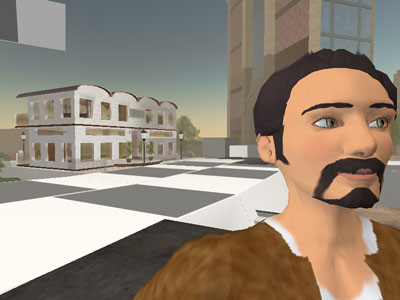
I’ve recently become part of the Second Life universe. Second Life is a true alternate reality where 3D avatars of real people do nearly all the things you’d expect in a real world community. It isn’t a game per se, unless you consider life itself a kind of game. Live, communicate, buy, sell, interact, build, be. You can pretty much do whatever you want. As with any reality, the happenings are being blogged. There’s even an online architecture review of buildings inside Second Life and a police blotter detailing in-world malfeasance.
Look for me as Immerito Foley. My bald spot flickers as I move around. Presumably this is due to some problem with the graphic texture but I rather like it. Might try that in the real world.
More on Second Life soon, I’d wager.

